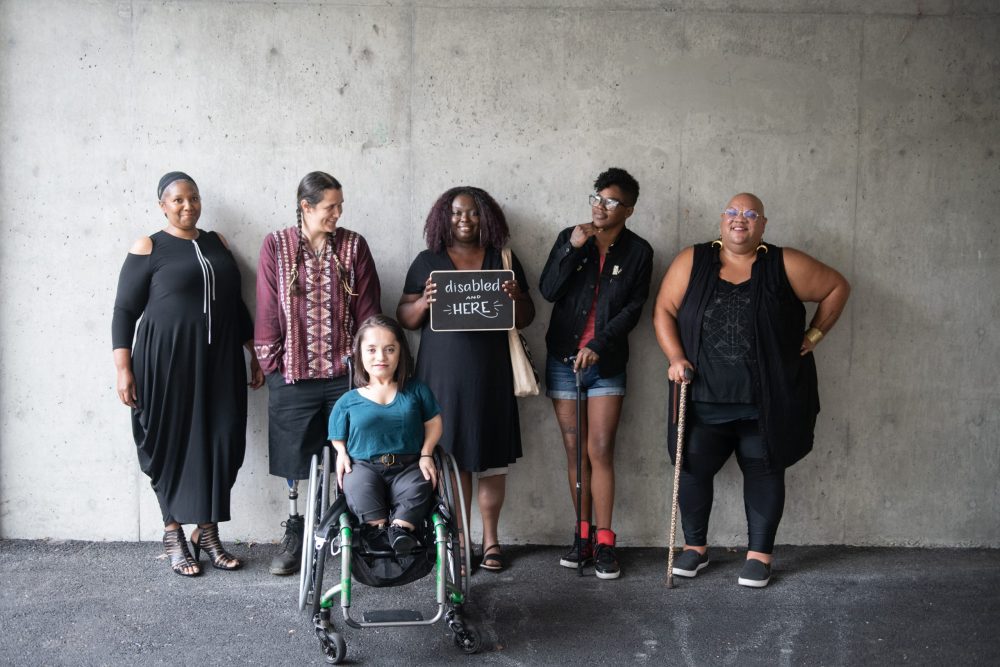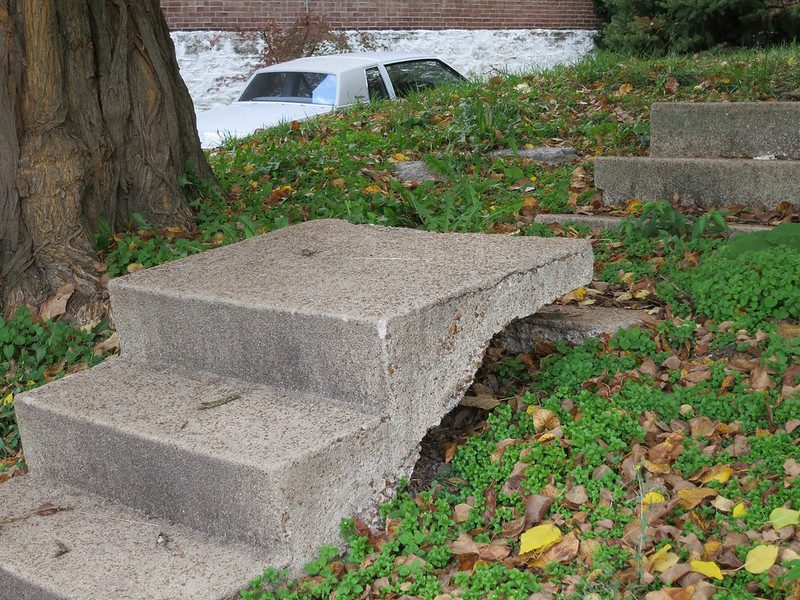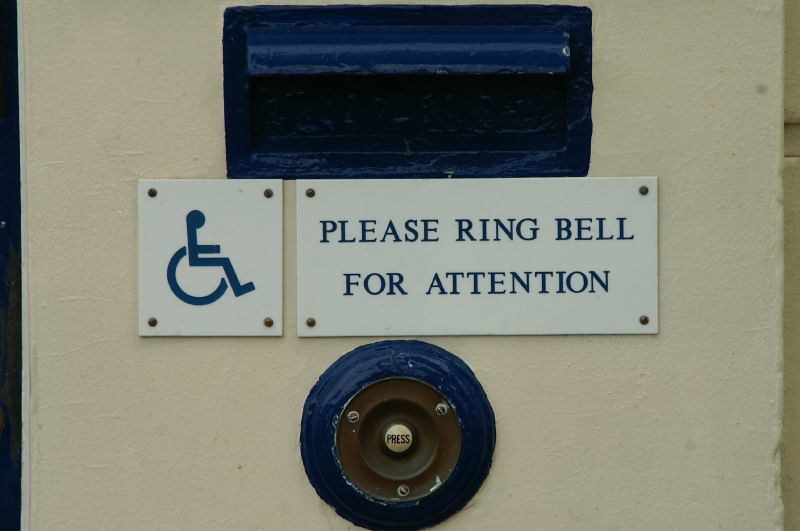This article is part of the Under the Lens series
Not Just Ramps—Disability and Housing Justice
In the early 1990s, activists in Austin, Texas, wanted to help disabled people who were stuck in nursing homes and other institutions gain their independence and move into regular housing. “Those kinds of places are really ghettos or gulags in some ways for people with disabilities,” says Stephanie Thomas, board president at Accessible Housing Austin! and a member of ADAPT, a national disability rights organization. “People can and should live in the community with everybody else, but for one reason or another they have a hard time.”
Thomas and other advocates in the 1990s soon discovered that one of the main problems was a sheer lack of homes with features like wider doorways, zero-step entrances, and lower-height kitchen counters.
“There didn’t seem to be places for people to move, and in fact, people sometimes had to wait for somebody to die to find an accessible apartment,” she recalls. “I was like, ‘Well, why is that? That’s so weird, because Section 504 of the Rehabilitation Act of 1973—that [passed] a lot of years ago.’”
‘It’s a national outrage, the way this whole thing has just kind of been treated as a cutesy, little side thing that you don’t really have to pay attention to.’
Section 504 says that in any housing development that receives federal funds, at least 5 percent of the units must be accessible for people with physical or mobility disabilities and 2 percent accessible for people with vision or hearing disabilities. In addition, since 1988, the Fair Housing Act has mandated a lower level of accessibility in all new multifamily housing with elevators and all ground-floor units in walk-up buildings, whether privately or publicly funded.
“I looked around and I found that they really weren’t enforcing the law here in Austin,” Thomas says. “I got a list of many of the places where they were supposed to be making [units] accessible, but they weren’t really enforcing that at all.”
That was the case in Austin and across the country in the ’90s, and to a great extent remains the case to this day. Section 504 is the federal government’s main tool for creating affordable, accessible housing, but activists across the country say local and federal officials enforce it only spottily, and developers and housing providers widely ignore its requirements.
“It’s a national outrage, the way this whole thing has just kind of been treated as a cutesy, little side thing that you don’t really have to pay attention to,” Thomas says.
Billions of Dollars, in Theory
Section 504 is important because it applies to dozens of federal programs worth tens of billions of dollars a year. They include public housing, the HOME Investment Partnerships Program, the Community Development Block Grant Program, Section 8 housing choice vouchers (excluding private landlords), the National Housing Trust Fund, Section 202 elderly housing, and U.S. Department of Agriculture rural housing programs.
Unlike the Fair Housing Act, which covers only new construction of multifamilies, Section 504 covers both new construction and renovation, which is critical for satisfying the huge need for accessible units, Thomas notes. In theory, it converts most federal housing programs into machines for generating accessible units.
Another law that often comes up in discussions of accessibility is the Americans with Disabilities Act (ADA), which bans discrimination in areas of public life including employment, education, transportation, and government services.
The ADA mandates accessibility of areas like sales offices, common rooms, and entryways in public housing, university dormitories, and some private developments. It does not cover living spaces, but it did lead to the Supreme Court’s groundbreaking 1999 Olmstead decision, which found that people with disabilities have a right to receive state-funded services in the community rather than in institutions. The ruling banned forced segregation of people with mental and physical disabilities in hospitals and nursing homes and paved the way for them to move into less restrictive settings.
About 39 million U.S. residents age 15 and older (12 percent) have physical disabilities, but only 4 percent of homes can accommodate people with moderate mobility difficulties, according to an analysis of the 2011 American Housing Survey. The same analysis found that only 0.15 percent of housing units were fully wheelchair accessible.
The shortage is particularly acute for people with low incomes, who have fewer housing options and are more likely to have disabilities. Among households with incomes below $30,000, one in 10 experiences poor “housing fit,” with 7 percent having difficulties getting around their homes and another 7 percent having difficulties using rooms, according to an analysis by Harvard’s Joint Center for Housing Studies. For households earning $75,000 or more, only 3 percent had fit problems.
The Harvard study also found ties between race and accessibility, although the gap fluctuated depending on age. Of all age ranges, housing accessibility varied by race most for householders over the age of 80.
HUD Funding for Integrated Housing
Another important program is Section 811 Supportive Housing for Persons with Disabilities, the only U.S. Department of Housing and Urban Development (HUD) program targeting non-elderly low-income disabled people. After a significant funding increase in the last two years, its current annual budget is $325 million. Section 811 funds originally went mostly toward building disabled-only developments but now often support integrated housing developments.
One component of Section 811, Capital Advance, pays nonprofit organizations to develop and run rental housing that offers optional supportive services, such as case management and employment assistance. The program emphasizes integration, limiting units designated for disabled people in its condo and multifamily developments to 25 percent. The Capital Advance program serves about 28,000 households in 2,390 properties, according to the National Low Income Housing Coalition (NLIHC).
A newer component, Project Rental Assistance, funds state housing agencies’ project-based programs. Since 2012, the program has “substantially [increased] integrated affordable rental housing units for persons with disabilities within existing, new, or rehabilitated multifamily properties with a mix of incomes and disability status,” according to the NLIHC. Its funds so far are projected to create 9,000 units.
The programs have made a difference in places like Austin. After years of protests, lawsuits, and lobbying by disability rights organizers, as well as federal policy changes, local officials are much better at enforcing the 5 percent rule, taking advantage of federal funding streams, and considering accessibility needs generally, Thomas says.
Last year, Accessible Housing Austin! cut the ribbon at Briarcliff, a 27-unit affordable apartment complex built with Section 811 dollars and other funding. Half of the units are accessible and the other half are adaptable for people with disabilities. It’s reserved for people who earn up to 50 percent of the area median income.
“We will rent to people who don’t need access—people without disabilities, and people with disabilities who don’t need access. We rent to any low-income person. Some of the units are 811 units, some of them are just income-restricted, and we take Section 8 housing choice vouchers,” Thomas says.
She recalls that in the 1990s United Cerebral Palsy was one of the first to take advantage of the flexibility offered by Section 811, using it to buy existing condos and make them into affordable, accessible units.
“It was in a regular complex with all kinds of other folks living there too. It was integrated in. That was a really cool idea and really cool way to go,” she says. “It was another creative way to use that money.”
Pushing for Higher Requirements
While Section 504 sets a minimum requirement of 5 percent of units accessible for physical disabilities and 2 percent accessible for hearing and vision disabilities, local or state housing agencies that parcel out federal funds may double the requirement to 10 percent and 4 percent, or go even higher if they wish. ADAPT and other advocacy groups occasionally lobby local officials for increases, citing census counts of disabled residents to show the need for more accessible units.
For example, more than a decade ago, advocates were able to convince the city of Philadelphia to raise the requirement to 10 percent, says Nancy Salandra, a member of ADAPT and director of independent living services at Liberty Resources in Philadelphia, although she says that they’ve since asked for a higher threshold.
Salandra notes that Los Angeles set an unusually high requirement in 2019, after HUD’s Office of Fair Housing and Equal Opportunity investigated the city’s noncompliance with Section 504, the Fair Housing Act, and the Americans with Disabilities Act. The city agreed to provide 11 percent mobility accessible units plus 4 percent sensory accessible units in new and rehabilitated buildings, retrofit 3,100 existing units, and provide “super-accessible” units in developments funded by programs like HOME and the 9 percent Low-Income Housing Tax Credits.
But Salandra and others say few municipalities or housing agencies agree to raise the percentage rules, even when they have large populations of people with disabilities. They say it’s an even tougher battle to get them to adopt visitability requirements, which are not required under federal law. Visitability, a concept championed by ADAPT organizer Eleanor Smith, is a basic level of accessibility for visitors to a home: one zero-step entrance, 32-inch-wide doorways, and one wheelchair-accessible bathroom on the main floor.
Philadelphia adopted a visitability requirement for developments supported by its Housing Trust Fund, which is funded with local deed-recording fees. But officials declined to mandate it more broadly, Salandra says. “We tried in Philadelphia for at least 15 years to get a visitability ordinance. Would have been the largest city to do that,” she says. “It was just outrageous. You can’t even get housing authorities to do it.”
Developers opposed to visitability mandates often cite the cost of accessibility features. Salandra says a new home can be made visitable for an added cost of $2,000 or less. But when the city of Philadelphia organized an accessibility-focused design charrette in 2010, a local building industry official said such efforts cost closer to $10,000 and also required other unpopular concessions, like giving up closet space to build a wider hallway.
Salandra believes the resistance from architects and developers goes beyond money. “They can’t fathom not having steps. They can’t understand that concept, that one entrance would have no steps,” she says. It may have to do with old notions about homes on hills being more private, or safer, or less vulnerable to flooding, she says. “There’s always been this huge pushback.”
Developers can also be conservative and habit-driven, and unwilling to adopt universal or barrier-free design recommendations from the federal government and other sources, Thomas says. “They have plans already drawn and then they just want to use them over and over and over,” she says.
More Resources, Better Recognition
The federal government enforces Section 504 and the Fair Housing Act in part by conducting compliance reviews of housing agencies and suing providers or developers that are not meeting their legal obligations.
Some of these cases target housing authorities, as in Los Angeles, that are failing to provide enough accessible units or act on tenants’ requests for home modifications and other accommodations. In response to U.S. Department of Justice lawsuits, housing authorities in Reading, Pennsylvania, and Bridgeport, Connecticut, among other cities, have in recent years agreed to build or renovate units or overhaul their systems for accommodating tenants. In November, HUD reached an agreement with the housing authority in Atlanta to remedy its Section 504 and ADA violations.
Civil rights organizations also file such cases, often with justice department endorsement. In 2016, for example, the Equal Rights Center (ERC) in Washington, D.C., won a federal court decision against Equity Residential, then the biggest multifamily housing developer in the U.S. Equity Residential had designed most of its nearly 300 housing complexes without required accessibility features. Another ERC case, against developer Archstone-Smith Trust, ended in 2005 with the company agreeing to retrofit complexes containing 12,000 apartments in 16 states.
Advocates say that current HUD officials are generally helpful on disability rights issues. The Trump administration was relatively hostile, ending a practice of quarterly meetings between a group of disability activists and HUD enforcement staff. Under the Biden administration, however, advocates participate in weekly conference calls with the HUD secretary’s office, says L. Dara Baldwin, director of national policy at the Center for Disability Rights, based in upstate New York.
Yet HUD does not do nearly enough, given the vast demand for more affordable, accessible housing, Baldwin and others say. Salandra says advocates have for years been asking the agency to hike the Section 504 requirement for physical accessibility to 10 percent or 15 percent for all developments, rather than leaving it to local groups to lobby for increases, one jurisdiction at a time. “They do move at glacier speed. That’s how they’ve always been,” she says of the agency.
In 2022, HUD put out an Advance Notice of Proposed Rulemaking aimed at improving Section 504, but it is unclear how or when the rule might change.
The federal agencies are also under-resourced to fight widespread ignorance and apathy toward disability rights, says Baldwin, whose work focuses broadly on legislative advocacy. “There’s only so much funding and enforcement,” she says. “When you talk about the ADA and accessibility—across the board, people just receive federal funds and do what they want to do. I can give you a list of where people just completely ignored ADA and said ‘we’re just not going to do that.’”
States and other entities know they don’t have to follow the laws because “no one’s going call them out on it,” Baldwin says. “That is why I have a job.”
Advocates nonetheless continue to press for improved regulations and laws. Salandra says they have asked members of Congress to insert higher accessibility requirements into various housing bills, so far without success. They also support the Eleanor Smith Inclusive Home Design Act, a House bill that would mandate visitability in all newly built single-family homes and townhouses receiving federal funds.
Another priority is more funding to create affordable housing, primarily Section 811 units specifically for disabled people. More Section 8 housing choice vouchers would also be helpful, provided that enough accessible units are created to accommodate the increased number of voucher holders. Salandra says housing agencies must allow flexible use of Section 8 funds to modify homes. Funds from the National Housing Trust Fund and other programs should also be put toward purchasing front-door ramps and adding other accessibility features to both new and existing homes.
Baldwin says disability-rights activists must constantly fight for basic acknowledgment of the need for accessibility, even from Democratic officials who are generally friendly to their cause. When Democrats update their official party platform every four years, it is still a struggle to get the word “accessible” into the housing section, alongside “affordable,” she says.
In 2020, “when housing was discussed, it was discussed in the context of affordable housing. It was not discussed in the context of accessible, affordable housing,” Baldwin says. “Until that public image changes, all of these programs, all of these things that we have, will never be used, because people don’t find it to be important.”
|
Help keep us strong by becoming a Shelterforce supporter. |






This article demonstrates the problem with using such a broad term as “disability.” The article – and too many policy makers – apply “disability” only to mobility impairments with a slight nod to sensory impairments. Accommodating people with physical disabilities is relatively easy; provide funds to make buildings accessible, and enforce laws requiring accessibility. Accommodating people with developmental and serious mental health disabilities is far more complicated and expensive. They typically need and they and their families typically desire housing exclusively for people with similar disabilities and with staff trained to provide appropriate assistance with their daily lives. Because these accommodations are far more complex and costly than (for example) installing zero threshold entries, housing set aside for people with disabilities generally is for those with physical disabilities. People with developmental and mental health disabilities thus are effectively denied access to housing with project based subsidies.